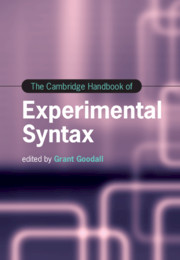Book contents
- The Cambridge Handbook of Experimental Syntax
- The Cambridge Handbook of Experimental Syntax
- Copyright page
- Contents
- Figures
- Tables
- Contributors
- Introduction
- Part I General Issues in Acceptability Experiments
- Part II Experimental Studies of Specific Phenomena
- Part III Experimental Studies of Specific Populations and Language Families
- Part IV Experimental Syntax beyond Acceptability
- 22 Theories All the Way Down
- 23 Eye-Tracking and Self-Paced Reading
- 24 Nothing Entirely New under the Sun: ERP Responses to Manipulations of Syntax
- 25 Corpus Studies of Syntax
- 26 Syntax and Speaking
- 27 Neuroimaging
- Index
- References
27 - Neuroimaging
from Part IV - Experimental Syntax beyond Acceptability
Published online by Cambridge University Press: 16 December 2021
- The Cambridge Handbook of Experimental Syntax
- The Cambridge Handbook of Experimental Syntax
- Copyright page
- Contents
- Figures
- Tables
- Contributors
- Introduction
- Part I General Issues in Acceptability Experiments
- Part II Experimental Studies of Specific Phenomena
- Part III Experimental Studies of Specific Populations and Language Families
- Part IV Experimental Syntax beyond Acceptability
- 22 Theories All the Way Down
- 23 Eye-Tracking and Self-Paced Reading
- 24 Nothing Entirely New under the Sun: ERP Responses to Manipulations of Syntax
- 25 Corpus Studies of Syntax
- 26 Syntax and Speaking
- 27 Neuroimaging
- Index
- References
Summary
Neuroimaging methods are of interest to those in search of non-traditional methods, and hopefully new insights, for the study of syntax. To the extent that activation in a “syntax area” of the brain can be used to discriminate among syntactic theories, we must have good confidence in the localization of syntax to begin with. Therefore what seem like separate interests – the linguist’s interest in using neuroimaging experiments to understand language, and the neuroscientist’s interest in spatial localization of language – are in fact inseparable. Section 27.2 introduces the reader to the various neuroimaging methods currently available and provides a crash course in the cortical neuroanatomy relevant to language. Section 27.3 reviews attempts to localize syntax in the brain through the use of neuroimaging methods. Section 27.4 discusses attempts to use neuroimaging data to adjudicate linguistic questions: the adequacy of syntactic theories, parsing models, and particular structural analyses.
- Type
- Chapter
- Information
- The Cambridge Handbook of Experimental Syntax , pp. 741 - 769Publisher: Cambridge University PressPrint publication year: 2021

